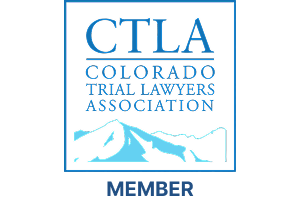Underride Truck Accidents
Underride truck crashes are among the most catastrophic roadway events. They occur when a smaller vehicle slides beneath the rear or side of a large truck or trailer. The geometry of the impact exposes occupants of the smaller vehicle to direct intrusion at head and chest level, which often leads to severe or fatal injuries. Federal rules exist to reduce underride risk, and courts across the country have addressed how those rules intersect with state tort law. At Cook Bradford & Levy, headed by trial lawyers Jason Levy and Brian Bradford, we investigate these cases with speed and precision, and we prepare them for trial from day one. Our team serves clients across Colorado from offices in Lafayette, Longmont, and Denver, and we invite you to call for a free consultation.
What Counts as an Underride Crash?
In a classic rear underride, a passenger vehicle strikes the back of a trailer and travels underneath it. Federal Motor Vehicle Safety Standards require most trailers and semitrailers to be equipped with rear impact guards that meet specified performance and installation criteria. Those rules apply to most trailers over 10,000 pounds gross vehicle weight rating, subject to narrow exclusions for certain configurations. Side underride occurs when a smaller vehicle slides beneath the long side of a trailer. Without side guards, a small car or motorcycle can penetrate under the trailer during lane changes, turns across traffic, or nighttime encounters where conspicuity is poor.
The Rules That Shape Underride Litigation
Rear guards and how they are supposed to work
Two standards operate together. FMVSS No. 224 requires covered trailers and semitrailers to have a rear impact guard, and FMVSS No. 223 defines how that guard must perform under specified loading conditions. The guard must be installed to precise height and lateral positions, remain rigid under load, and meet strength and energy-absorption criteria. Motor carriers also have duties under the Federal Motor Carrier Safety Regulations (FMCSR). Section 393.86 requires rear impact guards and rear end protection on certain commercial vehicles in interstate commerce, ties those requirements to FMVSS performance criteria, and addresses labeling and maintenance. These rules matter in litigation because they help identify who was responsible for ensuring that a guard was present, compliant, and in safe condition.
Recent regulatory updates and what they mean
In July 2022 NHTSA upgraded the rear impact guard standards to harmonize with Transport Canada requirements, raising performance expectations for new equipment. In June 2024 NHTSA denied a petition for reconsideration that sought further changes to those rules. These actions confirm that the federal baseline has moved upward, and they also underscore that compliance evolves over time as safety knowledge improves.
Compliance is not the end of the story
Manufacturers often argue that their trailers complied with the standards in effect at the time of manufacture. Courts have repeatedly held that compliance with a federal safety standard does not automatically preempt state tort claims or guarantee immunity from liability. The United States Supreme Court in Freightliner Corp. v. Myrick explained that tort claims may proceed when no specific standard controls the design alleged to be defective. Later, in Williamson v. Mazda Motor of America, the Court clarified that even where a standard exists, compliance does not foreclose state law claims unless Congress or the agency intended preemption. These opinions support the straightforward proposition that a guard can meet a minimum federal requirement yet still be unreasonably dangerous under state law if it fails to protect occupants in foreseeable crashes.
Why Underride Guards Fail In The Real World?
Real crashes are messy. They do not always match the test conditions a rule uses to define minimum compliance. Guards can be mounted too high, too narrow, or too far forward. Fasteners can loosen. Corrosion can weaken welds. Impact loads may hit closer to the edge of the guard where strength is lower. The 2022 upgrade to FMVSS 223 and 224 sought to improve real-world performance by updating the loading locations and force levels, but even a guard that technically complied can fail if poorly maintained or modified.
Side underride presents its own dynamics. Without side guards, a small car or motorcycle can penetrate under the trailer during lane changes or nighttime encounters. The National Highway Traffic Safety Administration’s June 2024 report to Congress surveyed the feasibility and cost of requiring side guards, and independent safety groups suggested that injury reduction potential may be substantially higher than government estimates. These developments are highly relevant when an underride crash involves side intrusion or the absence of recommended safety features.
How Cook Bradford & Levy Proves an Underride Case?
Immediate preservation and investigation
Time is your enemy after an underride crash. Our firm moves quickly to preserve the trailer and guard, to document crush patterns, and to download electronic logging and telematics that may show speed, braking, and lighting status. We secure police reports and any traffic camera footage, interview witnesses, and send preservation letters to ensure critical components are not repaired or destroyed before experts can examine them. Our approach is to investigate swiftly while preparing for trial from the outset. That preparation helps drive fair settlements and positions your case for court when needed.
Technical experts and testing
We retain accident reconstructionists, mechanical engineers, and sometimes metallurgists to analyze guard performance and vehicle dynamics. These experts can test exemplar guards to the performance criteria, examine bolt patterns and welds, and evaluate whether a different design or mounting configuration would have prevented intrusion. Where appropriate, we explore alternative designs including stronger vertical posts, extended horizontal members, or added diagonal supports that safety researchers and some manufacturers have adopted. Findings are anchored in federal standards and industry documents so that jurors can understand what failed and why that failure mattered.
Connecting regulations to liability
Federal rules and FMCSRs do not automatically decide liability, but they are powerful evidence of what safe practice requires. Section 393.86 connects carriers to guard requirements and maintenance. FMVSS 223 and 224 establish minimum design and installation criteria. Our trial team uses these benchmarks to explain to jurors where a design or maintenance practice fell short. We then tie those shortcomings to medical causation through occupant injury analysis and biomechanical testimony. The Supreme Court’s guidance on preemption keeps the focus where it belongs, which is whether the guard and truck were reasonably safe given foreseeable crash scenarios.
Negotiation backed by litigation readiness
Insurers evaluate risk. They pay attention when a case is built like it will be tried. We prepare comprehensive demand packages that summarize the reconstruction, defect analysis, medical harms, and damages. Our lawyers have completed numerous jury trials across Colorado and are prepared to file suit and pursue full discovery when reasonable settlement offers do not materialize. That willingness to litigate often moves negotiations forward.
Common Defenses and How We Address Them
The compliance defense
Defendants frequently argue that a trailer complied with the rule in effect when it was built. Compliance is relevant, but it is not a defense that automatically wins the case. Courts have made clear that federal compliance is not a liability shield where state tort law imposes a duty of reasonable safety and evidence shows the product was unreasonably dangerous in real-world use. We use testing, industry studies, and engineering analysis to demonstrate how a reasonable design would have averted intrusion even if the minimum regulatory box was checked.
The blame-shifting defense
Another defense is that the impact was too fast or too offset for any guard to help. Real cases show that juries will look beyond generalities and test the specifics. Could a sturdier design have engaged the striking vehicle’s crash structures sooner? Were there known feasible alternatives with superior performance under offset tests? Has the manufacturer itself released a stronger design in later years and promoted its increased protection? Those are fact questions that experts and documents can answer.
The maintenance gap
Even a strong guard can fail if it is loose, corroded, or damaged. Carriers must maintain equipment in safe operating condition and ensure that labeling and certification are intact, although an illegible label by itself does not prove noncompliance. We pursue maintenance records, inspection checklists, and repair histories to show whether the owner met its obligations to keep the guard safe and serviceable.
Damages in an Underride Case
The injuries in underride crashes are often devastating. Survivors may face traumatic brain injury, facial fractures, cervical spine injuries, and complex orthopedics. Families pursuing wrongful death claims confront final expenses, lost financial support, and the irreplaceable loss of companionship. Colorado law uses comparative negligence to measure damages and permits exemplary damages where the evidence supports willful and wanton conduct. Our job is to make the full measure of loss clear, from medical bills and lost earnings to life-care needs and human damages that do not show up on a spreadsheet.
Case Law and Verdicts that Illustrate Underride Issues
One highly visible example is the 2024 Missouri verdict in Perkins v. Wabash National Corp., where a St. Louis jury awarded $462 million after finding that a trailer’s rear impact guard design failed to prevent a fatal underride. The trial evidence indicated that the trailer was built in 2004, and although the guard complied with the standards applicable at that time, the jury found the design inadequate and returned substantial punitive damages. This outcome underscores the central litigation question in many underride cases: Did the guard reasonably protect against foreseeable rear impacts, not simply meet a minimum standard on paper.
Colorado juries and judges likewise analyze whether a defendant met its duties under state negligence principles, including whether violations of safety statutes or regulations support negligence per se. Colorado pattern jury instructions recognize negligence per se when a safety law protects a class of persons and the violation causes the type of harm the law was designed to prevent. In underride cases, that framework connects directly to proof regarding guard requirements, conspicuity, lighting, and maintenance.
Why Choose Cook Bradford & Levy for an Underride Case?
You want a firm that understands both the trucking rules and the product issues that underride cases raise. Our team has decades of combined experience standing up to large insurers and corporate defendants. We are a trial-ready firm that has litigated hundreds of cases, completed scores of jury trials, and recovered substantial results for injured Coloradans. We meet clients where they are, travel when needed, and stay available throughout the case. You can reach us in Lafayette, Longmont, or Denver. You can always start with a free consultation by calling 303-543-1000.
Frequently asked questions
Do I have a claim if the trailer met federal standards?
Yes, possibly. Federal compliance is a factor, not a defense that automatically wins the case. Courts permit state-law claims that challenge whether a product was reasonably safe under real-world conditions. Whether you have a claim depends on the facts, the design, and the performance of the guard in the crash at issue.
What if the underride occurred on the side of the trailer?
Side underride requires careful analysis of conspicuity, lighting, and the availability of side guards. Although side guards are not universally required, federal agencies have actively studied them, and safety organizations have advocated for broader adoption. A viable case may focus on whether a reasonable carrier would have used additional safety equipment or whether a manufacturer’s design choices increased risk beyond what a prudent design would allow.
Is there a deadline to act?
Yes. Colorado has statutes of limitation that restrict how long you have to file. Even more critically, key evidence can be lost quickly if it is not preserved. Calling an attorney early allows immediate preservation of the trailer and the guard, capture of electronic data, and notice to all involved that the equipment must not be altered. Our team is ready to act immediately to protect your rights.
Underride Crashes Demand Real Experience, Trust Cook Bradford & Levy to Investigate Fast and Fight Hard
Underride cases combine crash reconstruction, product design, and trucking regulation. They require a firm that can weave federal standards, evolving safety science, and state negligence law into a clear and compelling story for settlement or trial. Cook Bradford & Levy is led by Jason Levy and Brian Bradford, experienced trial lawyers who represent people, not insurance companies. If you or a loved one was hurt or killed in an underride crash, call for a free case evaluation. We will investigate promptly, consult the right experts, and build the strongest possible case for accountability and full compensation.









